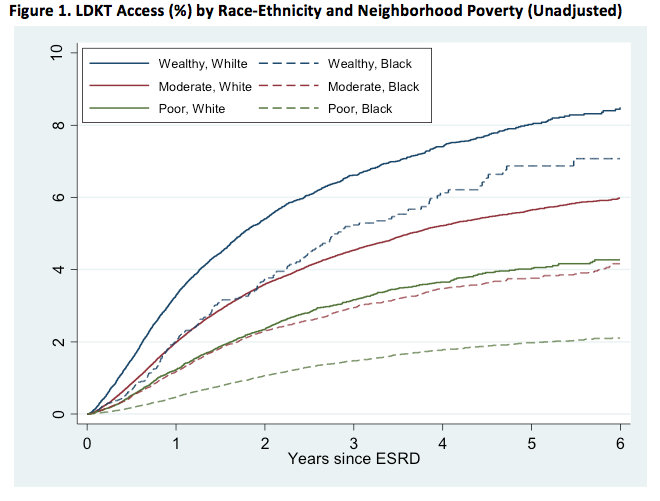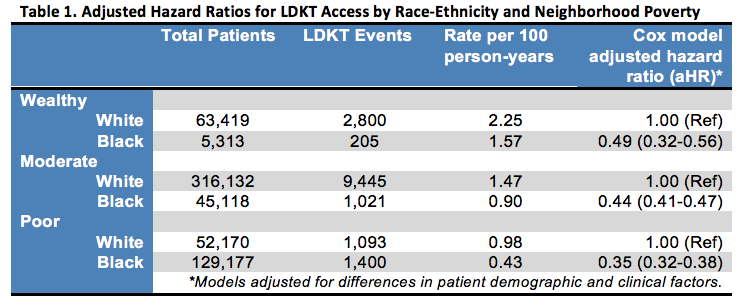Neighborhood Poverty and Racial/Ethnic Disparities in Access to Live Donor Kidney Transplantation in the US.
Johns Hopkins University, Baltimore
Meeting: 2017 American Transplant Congress
Abstract number: C55
Keywords: African-American
Session Information
Session Name: Poster Session C: Disparity in Access and Outcomes for Solid Organ Transplantation
Session Type: Poster Session
Date: Monday, May 1, 2017
Session Time: 6:00pm-7:00pm
 Presentation Time: 6:00pm-7:00pm
Presentation Time: 6:00pm-7:00pm
Location: Hall D1
Black transplant candidates have substantially lower rates of live donor kidney transplantation (LDKT) than their White counterparts. We hypothesized that neighborhood poverty might play a role in this disparity. METHODS: Using patient data from the United States Renal Data System (USRDS) linked with ZIP code-level data from the US Census, we performed multivariable Cox regression models to analyze the independent association of patient race/ethnicity with receipt of LDKT among 431,721 White and 179,608 Black adults who initiated treatment for ESRD between January 1, 2005 and June 30, 2012. We then tested whether neighborhood poverty modified the association of race-ethnicity with receipt of LDKT. We adjusted all models for differences in demographic and clinical factors, and we defined neighborhood poverty levels as poor (≥20% poverty), moderate (5-19% poverty), and wealthy (<5% poverty). RESULTS: Overall, Blacks were 59% less likely to receive LDKT than Whites (adjusted hazard ratio [aHR]: 0.41, 95% CI: 0.39-0.43, p<0.001). This disparity was magnified at increasing levels of neighborhood poverty. (Figure 1) Blacks living in wealthy neighborhoods were 51% less likely to receive LDKT than Whites (aHR: 0.49, 95% CI: 0.43-0.56, p<0.001), while Blacks living in moderate (aHR: 0.44, 95% CI: 0.41-0.47, p<0.001) and poor (aHR: 0.35, 95% CI: 0.32-0.38, p<0.001) neighborhoods were 56% and 65% less likely to receive LDKT than Whites. (Table 1) CONCLUSIONS: Neighborhood poverty is associated with more pronounced disparities in LDKT access for Black patients living in poor areas. Targeted efforts to identify and address clinical and socioeconomic drivers of this disparity are needed to improve LDKT access for this population. 

CITATION INFORMATION: Purnell T, Luo X, Crews D, Bae S, Kucirka L, Cooper L, Segev D. Neighborhood Poverty and Racial/Ethnic Disparities in Access to Live Donor Kidney Transplantation in the US. Am J Transplant. 2017;17 (suppl 3).
To cite this abstract in AMA style:
Purnell T, Luo X, Crews D, Bae S, Kucirka L, Cooper L, Segev D. Neighborhood Poverty and Racial/Ethnic Disparities in Access to Live Donor Kidney Transplantation in the US. [abstract]. Am J Transplant. 2017; 17 (suppl 3). https://atcmeetingabstracts.com/abstract/neighborhood-poverty-and-racialethnic-disparities-in-access-to-live-donor-kidney-transplantation-in-the-us/. Accessed December 14, 2025.« Back to 2017 American Transplant Congress
